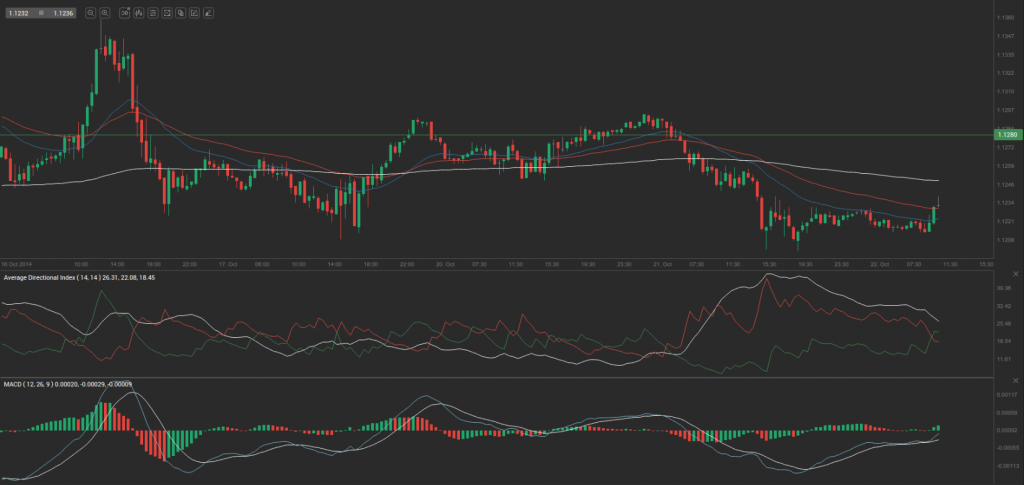Yesterday’s trade saw USD/CAD within the range of 1.1199-1.1299. The pair closed at 1.1221, losing 0.57% on a daily basis.
At 8:13 GMT today USD/CAD was up 0.12% for the day to trade at 1.1235. The pair touched a daily high at 1.1240 at 8:09 GMT.
Fundamentals
United States
The annualized index of consumer prices (CPI) in the United States probably decelerated to 1.6% in September, according to market expectations, from 1.7% in August. If so, this would be the third consecutive month of slowdown. In monthly terms, the CPI probably remained flat in September, following a 0.2% drop in the prior month, which has been the first in 16 months. In August prices of food and shelter rose, but the increases were more than offset by a decline in energy prices. The latter dropped at an annualized rate of 2.6% in August, while gasoline prices alone declined 4.1%.
The CPI is based on a basket of goods and services bought and used by consumers on a daily basis. In the United States the Bureau of Labor Statistics (BLS) surveys the prices of 80 000 consumer items in order to calculate the index. The latter reflects prices of commonly purchased items by primarily urban households, which represent about 87% of the US population. The Bureau processes price data from 23 000 retail and service businesses.
The CPI includes sales taxes, but excludes income taxes, costs of investments such as stocks and bonds and sales prices of homes.
The annualized Core CPI, which excludes prices of food and energy, probably remained unchanged at 1.7% in September. It is usually reported as a seasonally adjusted figure, because consumer patterns are widely fluctuating in dependance on the time of the year. The Core CPI is a key measure, because this is the gauge, which the Federal Reserve Bank examines in order to adjust its monetary policy. The Fed uses the core CPI, because prices of food, oil and gas are highly volatile and central bank’s tools are slow-acting. In case, for example, prices of oil surge considerably, this could lead to a high rate of inflation, but the central bank will not take action until this increase affects prices of other goods and services.
If the CPI tends to approach or comes in line with the inflation objective, set by the Federal Reserve and considered as providing price stability, or 2%, this will usually support demand for the US dollar. However, quite high rates of inflation (well above central bank’s inflation target) can be harmful to economy and as a result, this may lead to the loss of confidence in the local currency.
The Bureau of Labor Statistics is to release the official CPI report at 12:30 GMT.
Canada
Retail sales
Retail sales in the country probably increased 0.2% in August on a monthly basis, according to the median forecast by experts. In July sales dipped 0.1%. Retail sales, excluding sales of automobiles, probably expanded 0.2% in August, after a 0.6% drop in the preceding month. Large-ticket purchases are excluded due to their high volatility, which could influence the general trend. In case retail sales increased more than anticipated, this would provide support to the Canadian dollar. Statistics Canada is to release the official figure at 12:30 GMT.
Bank of Canada monetary policy decision
Bank of Canada’s (BoC) Governing Council probably left the target for the benchmark interest rate (overnight rate) without change at 1.0% at its policy meeting today, according to expectations. At its meeting on September 3rd the central bank left the Bank Rate at 1.25% and the deposit rate at 0.75%.
According to the most recent BoC Statement, ”inflation is close to the 2 percent target and is evolving as the Bank anticipated in its July Monetary Policy Report. Recent data reinforce the Bank’s view that the earlier pickup in inflation was attributable to the temporary effects of higher energy prices, exchange rate pass-through, and other sector-specific factors rather than to any change in domestic economic fundamentals. The risks to the outlook for inflation remain roughly balanced, while the risks associated with household imbalances have not diminished. The balance of these risks is still within the zone for which the current stance of monetary policy is appropriate and therefore the target for the overnight rate remains at 1 percent. The Bank remains neutral with respect to the next change to the policy rate: its timing and direction will depend on how new information influences the outlook and assessment of risks.”
Short-term interest rates are of utmost importance for the valuation of national currencies. In case Bank of Canada is hawkish about inflationary pressure in the economy and, thus, decides to introduce a rate hike, this will provide support to the loonie. Respectively, a decision to maintain or cut the benchmark rate, a result of a more dovish view, will have a bearish effect on the national currency.
The official policy decision is scheduled to be announced at 14:00 GMT.
Pivot Points
According to Binary Tribune’s daily analysis, the central pivot point for the pair is at 1.1240. In case USD/CAD manages to breach the first resistance level at 1.1280, it will probably continue up to test 1.1340. In case the second key resistance is broken, the pair will probably attempt to advance to 1.1380.
If USD/CAD manages to breach the first key support at 1.1180, it will probably continue to slide and test 1.1140. With this second key support broken, the movement to the downside will probably continue to 1.1080.
The mid-Pivot levels for today are as follows: M1 – 1.1110, M2 – 1.1160, M3 – 1.1210, M4 – 1.1260, M5 – 1.1310, M6 – 1.1360.
In weekly terms, the central pivot point is at 1.1278. The three key resistance levels are as follows: R1 – 1.1387, R2 – 1.1497, R3 – 1.1606. The three key support levels are: S1 – 1.1168, S2 – 1.1059, S3 – 1.0949.






